1
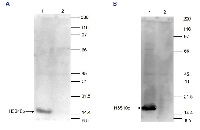
Anti-H3S10p | Histone H3 (p Ser10) (serum)
- Product Info
-
Immunogen: KLH-conjugated synthetic peptide Host: Rabbit Clonality: Polyclonal Purity: Serum Format: Liquid Quantity: 100 µl Storage: Store lyophilized/reconstituted at -20°C; once reconstituted make aliquots to avoid repeated freeze-thaw cycles. Please remember to spin the tubes briefly prior to opening them to avoid any losses that might occur from material adhering to the cap or sides of the tube. Tested applications: Chromatin immunoprecipitation (ChIP), Dot Blot (Dot), ELISA (ELISA), Immunofluorescence (IF), Immunoprecipitation (IP), Western blot (WB) Recommended dilution: 2 µg/million cells (ChIP), 1 : 20 000 (Dot), 1 : 2000 (IF), 5 µl (IP), 1 : 100 (WB) Expected | apparent MW: 15 kDa
- Reactivity
-
Confirmed reactivity: Human Predicted reactivity: Chicken, Drosophila melanogaster, Mouse, Plant, Rat, Xenopus sp. Not reactive in: No confirmed exceptions from predicted reactivity are currently known - Application Examples
-
application example 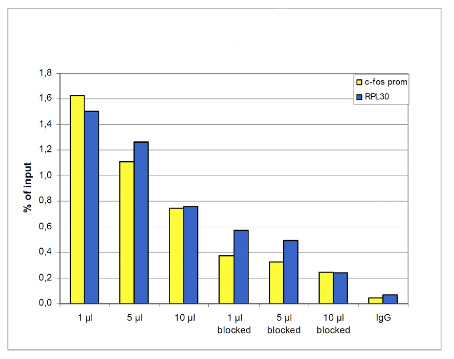
ChIP: assays were performed using human HeLa cells treated with colcemid and anti-H3S10p and optimized PCR primer sets for qPCR. ChIP was performed with the “LowCell# ChIP” kit using sheared chromatin from 10 000 cells. A titration of the antibody consisting of 1, 5, and 10 μ l per ChIP experiment was analysed. Additionally, ChIP was performed after incubation of the antibody with 5 nmol blocking peptide for 1 hour at room temperature. IgG (5 μ g/IP) was used as negative IP control. QPCR was performed with primers for the promoter of the active genes c-fos and RPL30. The figure shows the recovery, expressed as a % of input (the relative amount of immunoprecipitated DNA compared to input DNA after qPCR analysis).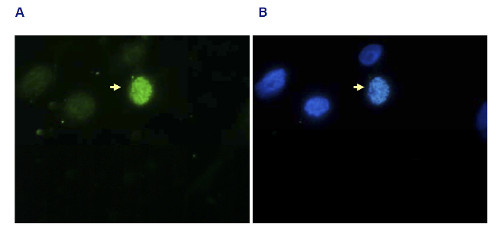
Immunofluorescence: Hela asynchronous cells were stained anti-H3S10p antibody and with DAPI. Cells were fixed with formaldehyde, permeabilized with sodium citrate and Triton X100 and blocked with PBS containing 2.5% BSA. (A) Cells were immunofluorescently labelled with the H3S10p antibody (diluted 1:200 and incubated for 1 hour at room temperature) followed by goat anti-rabbit antibody conjugated to DyLight® 488. (B) The nuclei were stained with DAPI, which specifically labels DNA. Phosphorylation of H3 on serine 10 occurs on condensed chromosomes during mitosis.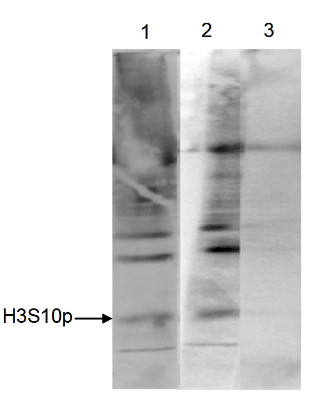
Immunoprecipitation: HeLa cells were treated with colcemid to block the cell cycle in metaphase and were fixed with formaldehyde. Chromatin from 10 000 cells was sheared and used for immunoprecipitation (IP). IP was performed with 5 μl of anti-H3S10p antibodies. The immunoprecipitated proteins were analysed by Western blot with the antibody diluted 1:500 in TBS-Tween containing 5% skimmed milk. Lane 1 shows the result of the IP; a positive control (sheared chromatin from 10 000 cells) and a negative IP control (no antibody added) are shown in lane 2 and 3, respectively.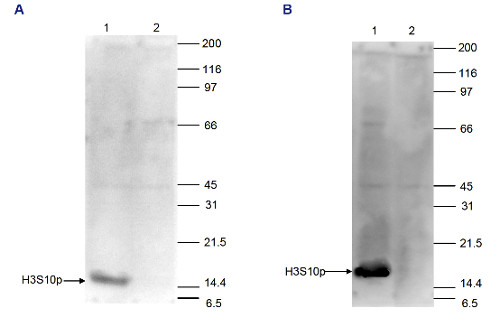
Western blot: HeLa cells were treated with TSA (figure A) or with colcemid (figure B), and 15 μ g of histone extracts of these cells were analysed by Western blot using anti-H3S10p antibodies diluted 1:500 in TBS-Tween containing 5% skimmed milk. The position of the protein of interest is indicated on the left; the marker (in kDa) is shown on the right. The result of the Western analysis with the antibody is shown in lane 1; lane 2 shows the same analysis after incubation of the antibody with 750 pmol blocking peptide for 1 hour at room temperature. - Additional Information
-
Additional information: This antibody preparation contains 0,05% sodium azide and 0,05% - Background
-
Background: Histones are the main constituents of the protein part of chromosomes of eukaryotic cells. They are rich in the amino acids arginine and lysine and have been greatly conserved during evolution. Histones pack the DNA into tight masses of chromatin. Two core histones of each class H2A, H2B, H3 and H4 assemble and are wrapped by 146 base pairs of DNA to form one octameric nucleosome. Phosphorylation of H3S10 is associated with mitosis. - Reviews:
-
This product doesn't have any reviews.
Accessories

AS10 710 | Clonality: Polyclonal | Host: Rabbit | Reactivity: A. thaliana, B. cinerea, C. reinhardtii, H. vulgare, S. lycopersicum, V. faba, P. tricornutum, P. patens, S. europaea, Z. mays | cellular [compartment marker] of nucleoplasm


